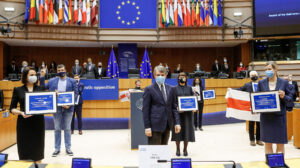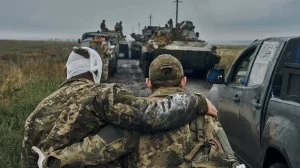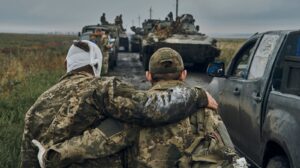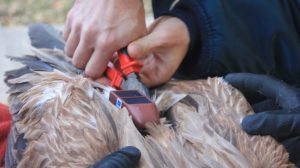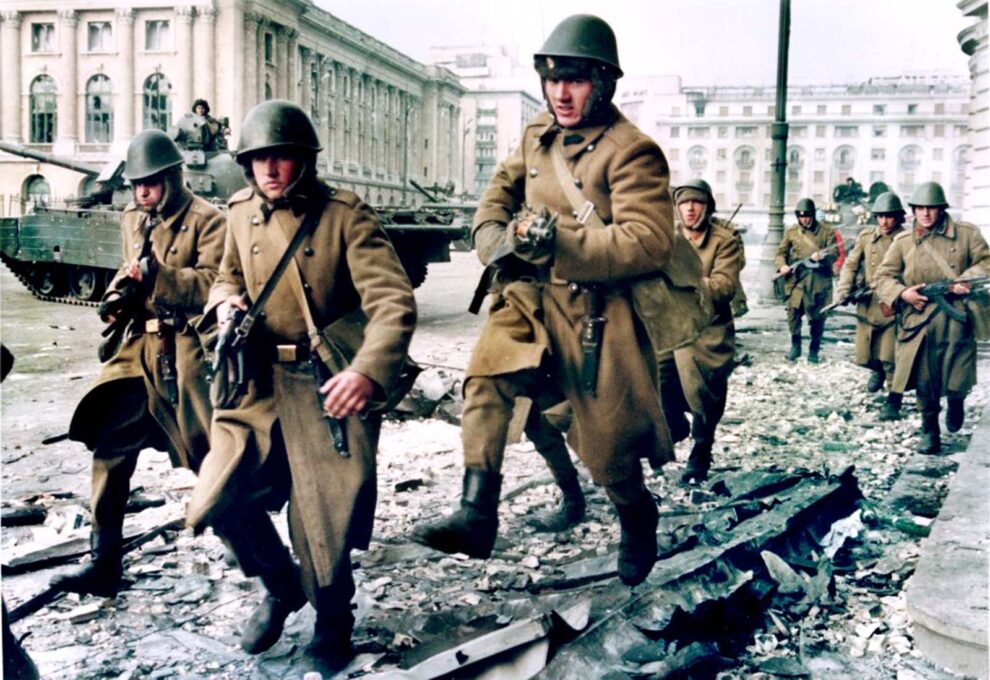BRASOV, Romania — On Romanian Heroes’ Day, Ileana Negru, a 66-year-old woman whose son Florin was just 12 when he was killed in the 1989 revolution, went to a mountain road outside the central city of Brasov, poured gasoline over her body, and set herself on fire.
Her May 25 suicide came after decades of suffering and what she said was humiliation at the hands of the state. Negru never found out who killed her son, nor was anyone ever held accountable.
Over three decades after the Romanian people overthrew and executed Ceausescu and his wife, Elena, in December 1989, her horrific death has brought renewed attention to the suffering of relatives of those who died in the revolution and who are still waiting for justice for their loved ones.
“On the day of her death, I met her at the Heroes’ Cemetery,” said Elena Vlase, whose 19-year-old son was tortured and killed in Brasov in December 1989. Both their sons are buried at the cemetery along with others of the 67 people who lost their lives in the city during the revolution, many when unidentified gunmen opened fire on unarmed crowds. “She was very unhappy. We arranged to meet the next day, [but] she never showed up.”
Negru’s suicide was not announced by the authorities or reported in Romania for two weeks. It was not until Negru’s daughter told Catalin Giurcanu, a former revolutionary who was 16 when he took to the streets to oppose the regime of Nicolae Ceausescu, that word of her death began to spread on social media. The pair had known each other for several years after meeting at protests calling for an official probe into the events of December 1989.
Police finally issued a terse statement about Negru’s death on June 8 and, on June 14, they made public what she had written in the suicide note found next to her body.
“In protest at 33 years of suffering, pain, humiliation, and mockery,” her note began, “today I end the humiliation, though it is costing me my life…. The revolution was ours and in no way belongs to the communists who stole it…. The injured heroes, those who were detained, they have special merits…. They spilled their blood in the name of freedom.”
In post-Ceausescu Romania, investigations into the more than 1,100 deaths and 3,000 injured in the bloody uprising have started, stalled, resumed, and stalled again. Cases have been passed from one prosecutor’s office to another and have periodically bounced from court to court.
“She wanted to know who killed her son, who the murderer was,” said Giurcanu, who was detained after he went out onto the streets in Bucharest when he heard people shouting, “Freedom, freedom!” His father came looking for him and died after being shot with 13 bullets to the chest. Some of the deaths during the revolution are thought to be due to incidents of friendly fire in the widespread chaos.
“So many bad things happened to her…. She was a tiny lady with a big heart,” Giurcanu said, tearing up during the interview. Less than a week before her death, he met with Negru, who was also known as Ileana Militaru after divorcing her husband. She had just returned from the Spanish island of Tenerife, where she lived with her daughter, who did not respond to an e-mail request for an interview.
Her son, Florin Negru, was one of 49 children who were killed during Romania’s revolution, which came a month after the fall of the Berlin Wall and ended Ceausescu’s nearly 25-year rule. The youngest to die was just 1 month old.
During the protests in Brasov, Negru sent Florin and his sister to her mother’s house for safety, but the 12-year-old snuck away. Speaking in a 2006 interview for a Romanian documentary, Negru said her son told her on December 17 that “those that don’t protest are cowards.”
At the time, news was quickly spreading that shooting had started in the western city of Timisoara, where locals had originally taken to the streets to protest the removal from his post of a popular pastor who had been critical of the regime.
On December 23, at the military hospital in Brasov, a city in the Transylvania region with a population of around 230,000, she found her son at an improvised morgue among a pile of bodies.
“He was lying on a jacket in his underpants, naked from the waist up. His eyes were open, and he was smiling. I ran and held him, and he was cold. I hugged him and that was the moment I began to scream. [His injuries meant] my son didn’t have a backbone. He was hollow. It was one big hole. That’s all I remember,” she said in the documentary interview.
Devastated and desperately seeking answers, the quest for justice for her son began with humiliation.
“In the fall of 1991, I was at the military prosecutor’s office,” she said in 2006. “A tall, balding man in military uniform came up to me — he didn’t introduce himself. ‘Are you the mother of [Florin Negru]?’ he asked. I said, ‘Yes.’ He said, ‘Your kid was a terrorist and a thief,'” and claimed he had stolen a ring and was helping other so-called terrorists.
Romanian officials pay lip service every December to those who died in the revolution, but the victims have gradually been forgotten. Giurcanu, whose father was shot dead, said he thinks he would “have had a chance to heal if there had been justice.”
People RFE/RL spoke to for this article say that the failure to secure justice for the victims was due to the revolution being hijacked by Ion Iliescu, a former high-ranking communist in the Ceausescu era who went on to be president three times, and lower-ranking communists who ran the country in the years that followed. In Negru’s suicide note, she singled out Iliescu, who she called “the torturer, the criminal who killed our children.”
A divisive figure in postcommunist Romania, Iliescu has been accused of spreading disinformation during the revolution and being among those leaders responsible for calling on miners to come to Bucharest in January and June 1990, and September 1991, to put down protests against the country’s new leaders.
Critics of Romania’s transition to democracy say many members of the former communist elite retained senior roles and now their sons, daughters, and proteges are in key positions. Because of that, they say, there’s little appetite for a proper investigation that would possibly implicate members of the army, the security services, and the widely feared secret police, the Securitate, who were never punished and live comfortably, many of them on generous pensions.
Iliescu, now 93, was charged in April 2019, along with two other high-ranking leaders, with crimes against humanity for the more than 850 deaths and 2,382 people injured that took place in the eight days after Ceausescu was overthrown on December 22 — the day Iliescu assumed power — and December 30.
Romania’s supreme court, the High Court of Cassation and Justice, which judges cases of ministers and high-level politicians, sent the case to the Court of Appeal on February 24, saying it had no jurisdiction in the case as Iliescu wasn’t president during the uprising. After serving as interim leader, Iliescu became president in the country’s first elections after the revolution in May 1990.
“They hid the death of [Ileana] Negru a whole 33 years after the revolution. The neo-communist, Securitate, and Bolshevik system lives on,” Sorin Boaca, a prominent participant in the revolution from Brasov, told RFE/RL. “She was the mother of a hero. This criminal system lives on through its children, descendants, and relatives.”
Not only has the case against Iliescu and former Deputy Prime Minister Gelu Voican Voiculescu and former military aviation head Iosif Rus dragged on for years, but critics of the proceedings say it has targeted only the most senior people of the time.
“Nobody has been charged in Brasov at all. How is this possible?” said Vlase, who said a member of the communist security services fired the shot that led to her son’s death. During a hearing, the man accused of being responsible denied any involvement and no charges have ever been brought against him.
But for those seeking justice in Brasov and elsewhere in Romania, there might be a glimmer of hope on the horizon with the appointment of history teacher Mihai Dodu in April to head a government institute that seeks justice for “anti-communist fighters.”
Dodu was just 9 years old when Ceausescu was overthrown, and his father was one of 79 people killed in gunbattles outside the building of the newly liberated TVR public television station in Bucharest.
“After [nearly] 34 years, for the first time we have the son of a hero and a martyr in this job. He has integrity. He must be left to carry out his job until the end,” Vlase said.
In addition to the monumental challenge of holding those responsible for the deaths accountable, the Romanians seeking justice must grapple with another issue: the estimated thousands of people who have falsely claimed to have taken part in the uprising and received revolutionary certificates, entitling them to compensation and other benefits, such as land, reduced rents on commercial space, and free public transport. There is ongoing hostility between the genuine and fake revolutionaries, some of whom have been prosecuted for lying about their involvement.
“I want to bring authenticity to the reputation of the revolutionaries, to get rid of the imposters,” Dodu told RFE/RL. “The obstacle to justice is not procedural but a lack of morality.”
Dodu is already facing calls to be fired after he ruled there were no grounds to upgrade the revolutionary certificate of Prime Minister Marcel Ciolacu to the top grade of “fighter with a decisive role” in the revolution.
There are five categories of revolutionary certificate: fighters who played an important role, fighters who had a decisive role, those who were jailed during the revolution, and those who lost a close relative. Benefits are higher for those who played a more active role, although these benefits were reportedly never taken by the prime minister.
Five participants in the revolution staged a hunger strike outside the government offices in Bucharest in July in support of Dodu, although Ciolacu has said he has no plans to remove him.
Dodu met Negru in his Bucharest office just days before she killed herself. She needed to change her own revolutionary certificate as the survivor of someone killed in the revolution to reflect her name change to Militaru.
“I corresponded with her, and she submitted the documents,” he said.
“Mrs. Negru moved me…. She said I was about the same age as her son would have been and that when she looked at me, she thought about him,” Dodu said. “Her death was a tragedy. Unfortunately, her gesture was the pain that all of us have lived with for more than 30 years with the question, in my case: Who killed my father?”
“After many years of suffering, caused by her son’s death, and the humiliation [at the hands of] the Romanian state, Mrs. Negru took the dramatic decision to end her life. This interview is upsetting for me…but I’m doing it for Mrs. Negru and the memory of those who died in the revolution,” he said.
His role in the government institute, he said, is to restore dignity to the victims of the revolution and their relatives, to improve their financial and health-care benefits, and for schools to be obliged to teach students about the revolution.
“We want the younger generation to understand the sacrifices that people the same age as them [now] made,” he added.
Ileana Negru now lies buried in a cemetery on the outskirts of Brasov. Boaca, who in 1989 was out protesting on the city streets, pointed out her grave, a small wooden cross banished to the corner of the graveyard next to a cornfield. Romania’s dominant Orthodox Church stipulates that suicide victims are to be buried on the farthest edges of cemeteries.
The Heroes’ Cemetery is smaller and neater, ringed by trees, and close to where Florin Negru was killed in downtown Brasov. There is a large cross with the name of those who died in the revolution.
“She was always crying a lot. Her 12-year-old son had died. She wanted him to be buried here in this cemetery,” said Vlase, standing next to her own son’s grave.
“[The perpetrators] have to face justice and pay,” she said. “Not just the top people in Bucharest but in Brasov. I feel my son has not found peace. I have to get dignity for him beyond the grave,” she said. “I want the criminals to be punished while I’m still alive.”
Source : RFERL









